
A Dictionary of the Fuchsia™
Want to know what those mysterious terms mean and just who the people were behind those names? Then this is the place for you.
Want to know what those mysterious terms mean and just who the people were behind those names? Then this is the place for you.
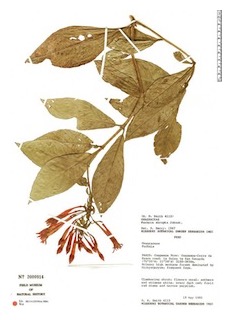
(Illustration: Specimen sheet of F. abrupta in the herbarium of the Field Musueum, Chicago.)
Actinomorphic – Actinomorphic ("star shaped" or "radial") flowers are characterized by radial symmetry, meaning they can be divided into identical sectors which are related to each other by rotation about the centre of the flower. This description is opposed to Zygomorphic ("yoke shaped" or "bilateral") flowers that can be divided only along a single plane into two mirror-image halves. Except for Fuchsia splendens, Fuchsia is actimomorphic.
Acuminate – Leaves that gradually narrow or taper to a long point at the apex.
Acute – Leaves in which the sides meet at the apex, base, or at both ends, in a pointed, acute angle of less than ninety degrees.
Acynifolia – Acinifolia, or having leaves resembling those of the basil plant, Ocinum basilicum. F. acynifolia (Scheidw. 1847) is a synonym of F. encliandra (Zucc., Steud. 1840) in ➤ Section Encliandra.
Adaxial – The side that's near, towards or adjacent to the axis or central line, such as the stalk of a plant, and often referring to being on the upper side.
Adnate – Two differing parts of a plant that are fused or linked together.
Appressed – Closely flattened or pressed on the surface. For example, appressed hairs on a leaf.
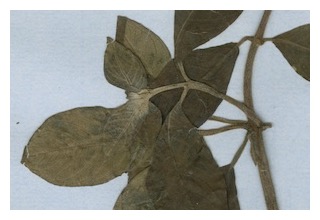
(Illustration: Detail of leaves in a dried botanical specimen of F. nigricans.}
Affinis – Related; similar; neighboring; allied to; kindred. F. affinis (Cambess 1830) is a synonym of F. regia ssp. serrae (Berry 1982) in ➤ Section Quelusia.
Adventitious – Developing from or in an unusual place on a plant. For example, fuchsias will occasionally develop adventitious roots from the stalks of leaves. See also Internodal Rooting.
Agamospermy – The asexual production of seeds from an ➤ ovule.

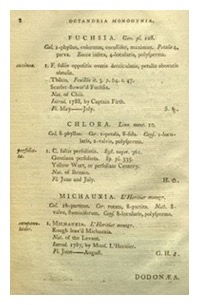
To add to the puzzle, that bad boy of British botany, Richard Salisbury (1761-1829), renamed the Kew specimen F. elegans in his Icones Stirpium Rariores in 1797 and stated that it had been introduced by ➤ Domingo Vandelli, the Italian botanist working in Portugal. Whatever the mystery's solution, preserved specimens taken from the actual plant soon after it was introduced at Kew are indeed from the actual species recognized today as F. coccinea.
Aiton was succeeded as director at Kew by his son, William Townsend Aiton (1766-1849).
(Illustrations: 1. Portrait of Aiton; 2. Entry for F. coccinea from the Hortus Kewensis, 1789.)
Aiton, William Townsend (1766-1849) – Son of William Aiton (see above). He succeeded his father as director of the Royal Botanic Gardens at Kew after his death in 1793 and remained its director until his retirement in 1841. Aiton released an enlarged second edition of his father’s Hortus Kewensis in 1810-1813 and was commissioned by George IV to redesign gardens at Buckingham Palace, originally landscaped by Capability Brown, and the Royal Pavilion in Brighton. He was also a founding member and fellow of the Royal Horticultural Society in 1804.
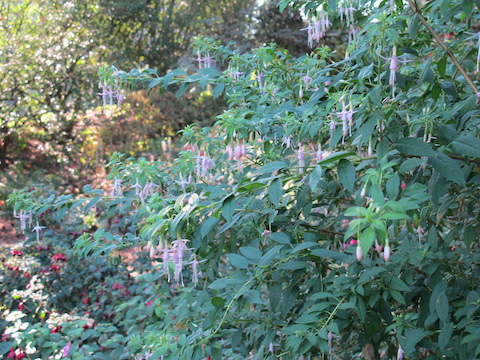
F. magellanica var. molinae (Espinoza 1929) is also considered to be based on another pale-flowered selection that is the same, or so close to the same as 'Alba’, as to be a synonym. Another pale-flowered description which lacks the fully normal red color in the sepals, F. magellanica var. eburnea (Pisano 1979), is also no longer valid.
See also ➤ Eburnea.
F. corymbiflora var. alba (Harrison 1849) is a synonym of F. boliviana 'Alba.' It appears to be a white-tubed mutation and is found only in cultivation or naturalized in areas where it has escaped from cultivation.
(Illustration: A very pale-flowered selection of F. magellanica variously called 'Alba' or 'Molinae'. These two names are functionally interchangeable. © Fuchsias in the City)
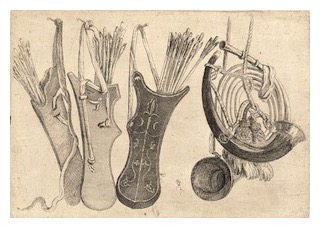
(Illustration: Quivers and Hunting Horns, engraving on paper, Wenceslaus (Wenzel) Hollar (1607-1677).
Allopolyploid – Polyploidy resulting when chromosomes are multiplied after two different species hybridize. See also ➤ Autopolyploid, ➤ Polyploid.
Allopatric – Not occurring in the same area and therefore geographically isolated and not able to interbreed. Subspecies of F. regia, for example, are often allopatric.
Alpestris – From the lower mountains. See F. alpestris (Gardner 1843) in ➤ Section Quelusia. F. integrifolia var. mollis (E.H.L.Krause 1906, Munz 1943), F. mollis (E.H.L.Krause 1906) and F. regia var. alpestris (Gardner 1843, Munz 1943) are all synonyms of F. alpestris.
Alternate – Leaves that are arranged along a stem in a staggered order from side to side. See also ➤ Opposite.
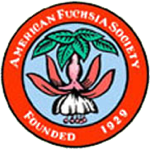
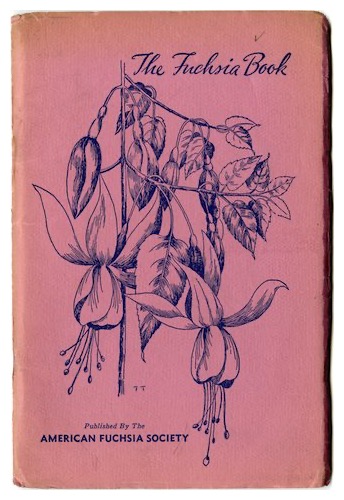
Almost immediately after the Society was established, a census and collection of fuchsias growing in California gardens and nurseries was undertaken under the scientific leadership and direction of Alice Eastwood. Armed with that list on a nine-month trip to visit gardens in Europe, Sidney Mitchell arranged for fifty-one new fuchsia cultivars to be shipped from England. Well prepared, forty-eight survived the long journey and were doled out to Society members and nurseries. These new plants, along with the about ninety-one cultivars already established in California gardens, would form the basis of an amazing flourish of fuchsias to emerge from California starting in the Thirties.
The AFS Registration Service was started in 1954 to help avoid the increasing problem of duplicate names, with Victor Reiter's 'Mantilla' (1948) being the first registration. The Society publishes the AFS Bulletin quarterly. Since 1967, the AFS has also been the official International Registration Authority for fuchsia cultivar names for the International Society of Horticultural Science.
(Illustrations: 1. Logo of the American Fuchsia Society; 2. Cover of The Fuchsia Book, American Fuchsia Society, 1948.)
Amoena – Delightful. F. amoena (De Candolle 1828) is a synonym of F. arborescens (SIms 1826) in ➤ Section Schufia.
Ampliata – Ampliate; widened or enlarged. Funnelform. See F. ampliata (Bentham 1845) in ➤ Section Fuchsia. No synonyms of this species are recorded.
Ancient Society of York Florists – Founded in 1768, the Ancient Society of York Florists is the oldest formally organized horticultural society in the world. The "florists" in its title preserves the original meaning of the word—amateurs growing flowers for their beauty—and does not refer to the professional tradesmen or shopkeepers selling cut flowers or plants today. At its inception, only six kinds of flowers were exhibited by the Society but later in the nineteenth century other newly introduced and popular flowers, such as chrysanthemums and fuchsias, were added to the roster of its shows often years before these plants had specialist societies of their own.
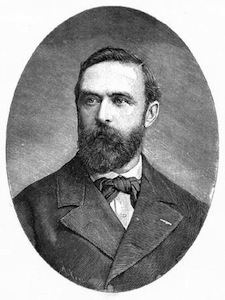
André was quite the prodigy, however. By 1860, at the age of only twenty, he was in Paris where he worked with such luminaries of the Second Empire as Adolphe Alphand (1817-1891), Jean-Pierre Barillet-Deschamps (1824-1873) and Baron Georges Hausmann (1819-1891) on the grand redesign of the city’s boulevards and parks which still defines the French capital's look and feel today.
Among the many projects were the design and plantings of such quintessential Parisian spaces such as the Parc des Buttes-Chaumont and the Tuileries Gardens. Eventually he was Jardinier principal in the Service des Promenades et Plantations de la Ville de Paris, a position he held for eight years. Other projects in France included the Champ de Mars in Montpellier, the Public Garden in Cognac and the world’s largest rose garden at L’Haÿ-les-Roses.

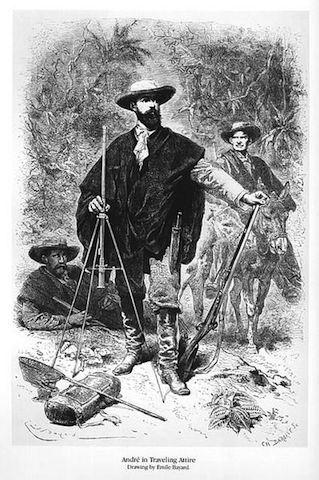

A number of André's specimens were evidently collected for him by other plant hunters on commission. It was the Belgian Hugo Poortman (1858-1953) who seems to have collected F. scherffiana, much further south in the Loja and Zamora-Chinchipe Provinces of Ecuador than André himself visited. However, this doesn't seem to be the case with another of André's fuchsia collections, F. vulcanica, as he passed directly through the Chimborazo province, home of the mighty Chimborazo volcano, to which it's native (see Vulcanica).
Especially interested in bromeliads, André also published his collections of this family as Bromeliaceae Andreanae. Description et Histoire des Bromeliacées récoltées dans la Colombie, l'Ecuador et la Venezuela.
See F. andrei in ➤ Section Fuchsia.
(Illustrations: 1. Portrait of Édouard André, ca.1880; 2. André's plan of Sefton Park, Liverpool, 1866; 3. André in Traveling Attire, Émile Bayard, about 1880; 4. Exploration dans l'Amérique du Sud par Édouard André, Carte des divisions politique de républiques de la Colombie et de l'Équateur. Édouard André, “L’Amérique Équinoxiale (Colombie – Équateur – Pérou),” Le Tour du Monde, 1877.)
Andrei – Named in honor of Édouard François André (1840-1911). See: André; F. andrei (Johnston 1925) in ➤ Section Fuchsia. F. osgoodii (J.F.Macbr. 1941) and F. ovalis var. aberrans (J.F.Macbr. 1941) are both synonyms of this species.
Angiosperms – Flowering plants; the group of plants characterized by having ovules enclosed in an ovary.
Annular – In the shape of an annulus or ring; ring shaped; ringed; forming a ring.
Anthesis – The period at which a flower is fully opened and has become fully functional.
Anther – The sac-like part of the stamen where pollen is produced. It is located at the end of the filament.
Anthocyanins – A group of pigments in flowers that give them their blue or red colors.
Anthropophily – Pollination by man.
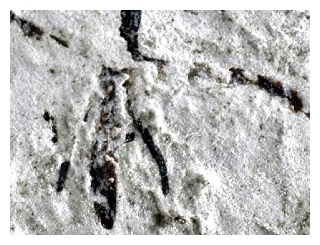
Antiqua – Old or ancient. Based on the discovery of a fossilized Fuchsia flower and a separate associated fossil of an Fuchsia anther mass, the first fossil-taxon of Fuchsia was described by paleobotanists in the October 2013 issue of the American Journal of Botany. Found in limestone dating to the early Miocene (23 mya), Fuchsia antiqua apparently grew on the banks of an ancient lake in New Zealand and is related to the four modern Fuchsia species in the Skinnera and Procumbentes sections. The flower, which is barely two centimeters in length, and the separate anther clump were preserved in fine silt at the bottom of the lake.
See "For the new year, an old fuchsia. Fuchsia antiqua sp. nov." in the ➤ Urban Fuchsia + Blog.
(Illustration: Detail of the fossilized Fuchsia flower published in Daphne E. Lee, John G. Conran, Jennifer M. Bannister, Uwe Kaulfuss, and Dallas C. Mildenhall. "A fossil Fuchsia (Onagraceae) flower and an anther mass with in situ pollen from the early Miocene of New Zealand", American Journal of Botany 100(10), October 2013, pp. 2052-2065.)
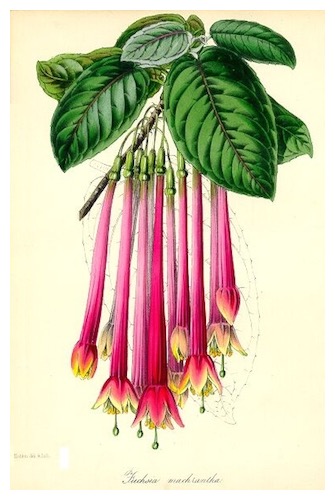
(Illustration: F. apetala labeled as F. macrantha. Paxton's Magazine of Botany, 1850.)
Apetalous – Without petals, lacking petals Fuchsias in the ➤ Hemsleyella section of the genus all have this lacking characteristic.
Apex – The tip a leaf, petal or similar part of a plant opposite to the end to where it's attached. For example, the apex of a leaf.
Apical – Connected with the apex, i.e. at the tip; at the growing tip of the plant's stem or roots, in comparison with intercalary growth that occurs between areas of a plant's permanent tissue. For example, an apical bud.
Apiculata – Apiculate; leaves that have a short, sharply pointed tip. F. apiculata (I.M. Johnston 1925) is a synonym of F. loxensis (Kunth 1823) in ➤ Section Fuchsia.
Aphids – Various Aphis species can do damage to fuchsias with their feeding, especially at the tips of branches, or can encourage the growth of diseases developing on their sugary secretions. A number of low-key organic methods, including lady bugs or even simple sprays of water, are often very effective in combatting infestations of these pests. Additionally, chemical controls might be used.
Apomixy – Asexual reproduction; reproduction without fertilization, meiosis, or the production of gametes.
Aprica – Sun loving. F. aprica (Lundell 1940) is a synonym of F. microphylla subsp. aprica (Lundell Breedlove 1969), as is F. microphylla var. aprica (Lundell Munz 1943), in ➤ Section Encliandra.
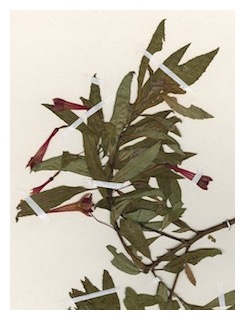
(Illustration: Detail from a dried specimen of F. aquaviridis preserved at the Botanical Institute, Aarhus University, Denmark.)
Araucana – Named for the native Arauco (Mapuche) people of southern Chile. F. araucana (F.Phil 1876) is a synonym of F.magellanica (Lam. 1788) in ➤ Section Quelusia.
Arete, Aretillo – Primarily Mexican ➤ common name for the fuchsia. Literally "earring" and "little earring" and alluding to another common name for the fuchsia in Spanish, Pendientes de la Reina.
Arborea – Tree-like. F. arborea (Sessé & Moç. 1888) is a synonym of F. arborescens (Sims 1826) in ➤ Section Schufia.

There are also other tell-tale differences in the flowers as well. The flower buds of F. arborescens, for example, are generally larger, broader and more blunted towards the tips than the comparatively longer, narrower ones of F. paniculata.
See F. arborescens (Sims 1826) in ➤ Section Schufia. F. amoena (de Candolle 1828), F. arborea (Sessé & Moç. 1888), F. arborescens var. arborescens, F. arborescens var. typica (Munz 1943), F. arborescens var. syringiflora (Lem. 1848) and F. syringiflora (Carrière 1873) are all synonyms of F. arborescens. F. arborescens var. megalantha, (Donn.Sm 1893), F. arborescens f. parva (Munz 1943) and F. arborescens f. tenuis (Munz 1943) are all synonyms of F. paniculata (Lindl. 1856)
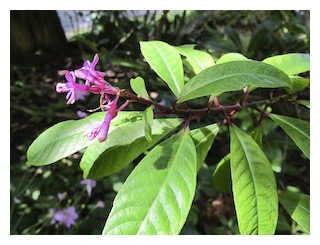
Arborescent – Tree-like. See ➤ Aborescens.
Asperifolia – Rough-leaved. F. asperifolia (Krause 1905) is a synonym of F. pilosa (Fielding & Gardner 1844) in ➤ Section Fuchsia.
Aspiazu, Dr. Rufino (1912-201?) – Distinguished physician and surgeon in Lima, Peru, as well as an ardent amateur botanist and plant collector, who often provided invaluable assistance to botanical expeditions his country. F. aspiazui (Macbride 1941) is synonymous with F. abrupta (Johnston 1925). See F. abrupta in ➤ Section Fuchsia.
Aspiazui – Named in honor of Dr. Rufino Aspiazu (1912-201?). F. aspiazui (Macbride 1941) is a synonym of F. abrupta (Johnston 1925). See above Aspiazu; and F. abrupta in ➤ Section Fuchsia.

While he did undertake several research expeditions within his native country and was noted as an expert on Nordic vascular plants, Asplund's major focus was to be on the flora and vegetation of South America. His first major field trip was to Bolivia already in 1920-21, at which time he also collected in Chile, Venezuela, Panama and Brazil. Asplund returned to collect in Ecuador, Peru and Colombia from 1939-40. He undertook a third expedition to Ecuador, Peru and Venezuela in 1955-56.
His collections, noted for their meticulous preparation, are today preserved in the Regnellian Herbarium at the Swedish Museum of Natural History. F. asplundii (Macbride 1941) was named in his honor but is now synonymous with F. ayavacensis (Humboldt, Bonpland & Kunth 1823). There are, however, well over sixty species of other plants that still hold his name in some form and two full genera, Asplundia (Cyclanthaceae) and Asplundianthus (Asteraceae), are named for him as well.
See F. ayavacensis in ➤ Section Fuchsia.
Asplundii – Named in honor Erik Asplund (1888-1974). Fuchsia asplundii (J.F.Macbr. 1941) is a synonym of F. ayavacensis (Kunth 1823). See above Asplund; and F. ayavacensis in ➤ Section Fuchsia.
Atrorubra – Dark red. F. atrorubra (I.M.Johnst. 1925) is a synonym of F. nigricans (Linden ex Planch. 1849) in ➤ Section Fuchsia.
Attenuate – Leaves that gradually taper at the base into a petiole-like extensions.
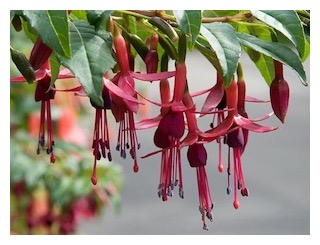
(Illustration: Fuchsia 'Whiteknights Amethyst' © Fuchsias in the City)
Auculops fuchsiae – See Fuchsia Gall Mite.
Austromontana – From the southern mountains. See F. austromontana in ➤ Section Fuchsia. No synonyms of this species are recorded.
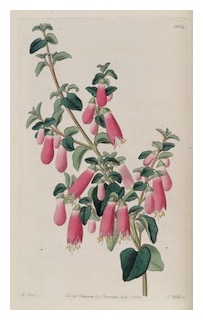
(Illustration: Correa pulcella drawn by M. Hart from Edwards’s Botanical Register, 1829, vol. 15: t. 1224.)
Author – In botany, specifically the first person to validly publish a new taxon.
Author Citation – Refers to the person or persons who first validly published a botanical name fulfilling the formal requirements as specified by the International Code of Botanical Nomenclature, or ICBN (see also). It's customary (though not obligatory) to abbreviate authors' names according to the recognized list of standard abbreviations. In those cases where a species is no longer in the genus of its original placement, such as a new combination of a genus with the specific epithet, both the author of the original genus placement and the author of the new combination are often given, with the former name being placed within parentheses. The ➤ International Plant Names Index maintains a list authors' names and their standard abbreviations.
Autogamy – Self fertilization.
Autopolyploid, Autoployploidy – ➤ Polyploidy resulting when chromosomes are multiplied within a single species.
Auxins – Plant hormones or growth substances that play an important role in coordinating many processes during the plant's life cycle and are essential for its development.
Axil – The inside junction of the leaf and stem. New shoots or flowers develop from buds inside this joint.
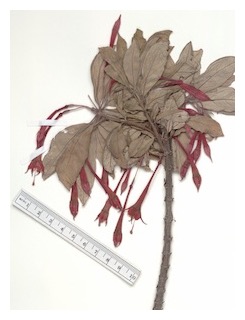
Ayavacensis – From Ayabaca Province in Peru. See F. ayavacensis (Kunth 1823) in ➤ Section Fuchsia. F. asplundii (J.F.Macbr. 1941) and F. townsendii (I.M.Johnst. 1925) are both synonyms of this species.
(Illustration: Detail from a specimen sheet of ➤ F. ayavacensis preserved at the Missouri Botanical Garden.)
Ba nab tz'i'lei – Fuchsia splendens in Tzotzil, the language spoken by the Maya in the state of Chiapas, Mexico.
Bacillaris – Rod-shaped; resembling a small staff or wand, from the Latin diminutive of baculus, a staff or walking stick. F. x bacillaris (Lindl. 1832) is now considered to be a natural hybrid between Fuchsia microphylla subsp. microphylla and Fuchsia thymifolia subsp. thymifolia. See in ➤ Section Encliandra. Brebissonia bacillaire (Spach 1835) and F. × cinnabarina (D.C.McClint. 1950) are both synonyms of this hybrid.
Backcross – In hybridizing, re-crossing a plant with one its parents.
Banks, Edward (1820-1910) – Early English hybridizer who produced numerous new cultivars at his nursery in Deal, Kent. Banks purchased Sholden Lodge as a newly-wed in 1841 and lived there until his death at the age of ninety. His large greenhouse was manned by a staff of ten gardeners. Among his enduring introductions were 'Arabella’ ‘Beauty of Sholden’, ’Forget-me-not' and 'Rose of Castile.' An exact count of his many introductions is unknown but may have been anywhere from 110 to 177 according to various reports. Interestingly, Banks was the grandson of Sir Edward Banks, a prominent builder whose firm was responsible for Waterloo, Southwark, and London bridges.

Previously, in the middle of January 1768, while the ship waited for favorable weather to pass into the Pacific and the crew took on wood and fresh water, Banks undertook a plant-hunting expedition along the shore at Cape Horn. Unfortunately, he was forced to withdraw and return to the ship by a heavy snowstorm, in which the two African servants who had accompanied him from England died of
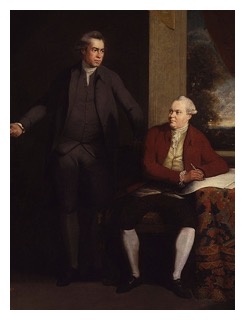
In later life Banks became a leading patron of the natural sciences and had a close relationship with George III, serving as a sort of botanical minister to develop economical uses for plants in Britain, as well as in its territories around the world. Based at Kew after 1773, he assumed, in his own words, "a kind of superintendence" for the gardens and was largely responsible for establishing Kew's leading position around the world. In fact, Banks was often such as enthusiastic supporter that he frequently couldn't wait for the gardeners to move new arrivals; he's said to have triumphantly carried the first fuchsia to the greenhouse at Kew on his head (see also Aiton).
He was created a baronet in 1781.
(Illustrations: F. excorticata from Banks' Florilegium; Detail of Banks (standing) and Solander (seated) from a painting by William Parry, about 1775-76.)
Barclayana – F. barclayana (A.Cels & J.F.Cels 1837) is not a currently accepted species and remains unresolved as a synonym.
Barker, Cecily Mary – See ➤ Fuchsia Fairy.
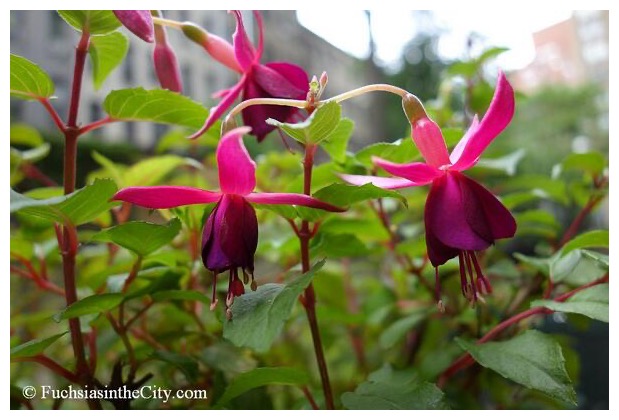
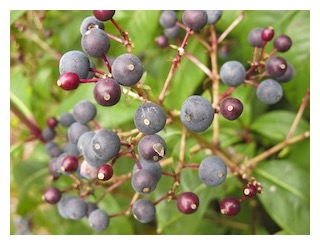
(Illustrations: Berries in various stages of ripeness on F. paniculata at right; berries on F. boliviana var. alba below. © Fuchsias in the City)
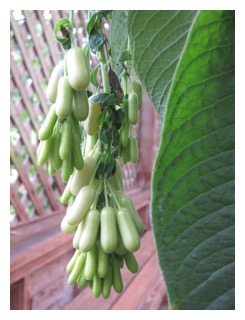
Biennial, Biennial Method – The practice of growing plants from one year to flower in the following year. The resulting specimens are usually larger and stronger than if they were grown from cuttings taken in the late winter or spring to flower by the summer. The method was used to create the spectacular fuchsia pyramids, for example, so popular in grand Victorian gardens and estates before the First World War. See ➤ Column, ➤ Cone, ➤ Pyramid.
Biflora – Having two flowers. F. biflora (Sessé & Moç. 1894) is no longer a valid species but its current identification seems unresolved. It is either a synonym of F. cylindracaea (Lindl. 1827) or F. parviflora (Lindl. 1827), which is itself now a synonym of F. encliandra.
Binomial – A two-part name. Since introduced by Linnaeus (see also)in his Species plantarum in 1753, the scientific name of any species is a binomial in which the first part is the genus and the second, the species. Fuchsia magellanica, for example is the binomial designation for that species.
Blackfly – See Aphids.
Boliviana – Bolivian; from Bolivia. See F. boliviana (Carrière 1876) in ➤ Section Fuchsia. F. boliviana var. luxurians (I.M.Johnst. 1925), F. boliviana f. puberulenta (Munz 1943), F. corymbiflora var. alba (Harrison 1849) F. cuspidata (Fawc. & Rendle 1926) and F. lenneana (Warcz. 1852 [invalid publication]) are all synonyms of F. boliviana. F. boliviana (Britton 1890) is illegitimate and a synonym of F. sanctae-rosae (Kuntze 1898).
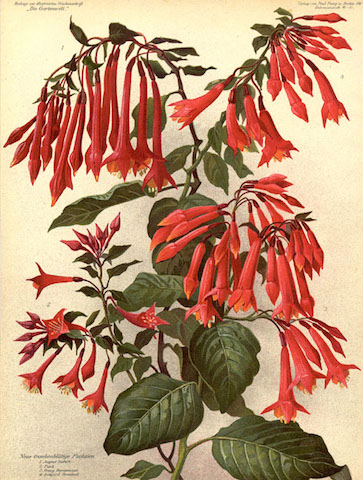
Initially trained in Germany at the Pomologische Institut in Proskau (now Prószków, Poland) Bonstedt spent a number of his early years in England at Kew where he would have almost certainly developed his interest in F. triphylla. Seeds of the species had been sent there for identification in 1882 after being collected in Haiti for the New York nurseryman, Thomas Hogg, Jr. (see also). The rediscovery of the long-lost type species for Fuchsia caused great excitement in the botanical and horticultural world at the time. After Kew, Bonstedt was appointed director of the Botanical Gardens in Rostock, located on the Baltic coast of Germany, from 1892-1900.
In 1900, Bonstedt became Inspektor des Gartens (Technical Director) of the historic Göttingen Botanical Gardens of the University of Göttingen, located in the German state of Lower Saxony, where he also lectured on horticulture. Founded in 1734 by George II, King of Great Britain and Elector of Hanover to promote the Enlightenment, the university started classes in 1737. The University's Old Garden was already established in 1736, though. The Alpine Garden was added under Bonstedt's direction. He remained at Göttingen until his retirement in 1931. Even after his retirement, Bonstedt continued to write and lecture widely on horticultural subjects. He was the author of a number of books such as Schnittblumen: Handbuch für den Praxis des Schnittblumenbaues (1937) as well as the editor of the popular reference work, Parey's Blumengärtnerei.
The genus Bonstedtia H.R.Wehrh. 1930 (Berberidaceae) in the barberry family, is named in his honor (Gartenstaud. 1: 455. 1930).
Full list: 'Mary' [crossed 1894 but released via Bornemann 1897], 'Frau Line Bonstedt', 'Göttingen' [also 'Gartenstadt Göttingen], 'Fürst Otto von Stolberg' [also 'Fürst Otto', 'Otto Fürst von Stolberg', 'Otto Fürst von Stolberg-Wernigerode, and other variations; often misspelt Stollberg], (1904), 'August Siebert', 'Gartenmeister Bonstedt' [also 'Late Perfection'], 'Jelängerjelieber', 'Koralle' [also 'Coralle'; Bornemann released it as 'Koralle' but Bonstedt later writes 'Coralle'], 'Thalia', 'Traudchen Bonstedt' [also 'Fräulein Bonstedt'] (1905), 'Clio', 'Eros', 'Perle' (1907), 'Irmgard Bonstedt', 'Puck', 'Winterkönigin' [also 'Winterblüher'], 'Georg Bornemann' [also 'Bornemanns Beste', 'Bornemann's Beste', and 'Georg Börnemann' [sic]; only introduced by Bornemann in 1926] (1915).
(Illustrations: Bonstedt cultivars 'August Siebert', 'Puck', 'Georg Bornemann', and 'Irmgard Bonstedt'. Contemporary drawing by the celebrated Johanna Beckmann published in Die Gartenwelt, Illustrierte Wochenschrift für den gesamten Gartenbau, 1915, Volume 19.)
Boothby, Clara Lady (1887-1951) – Founder and first president of the British Fuchsia Society in 1938. During a visit from her friend Queen Mary to Lady Boothby's home at Fonmon Castle in Glamorgan, Wales, the Queen reportedly saw an advertisement for the meeting of a local group called F.U.C.H.S.I.A.S. When told that it was a political organization that had nothing to do with fuchsias in the garden, Queen Mary expressed disappointment and stated that there should really be a fuchsia society and that Lady Boothby should be its first president. Lady Boothby and a small circle of fuchsia enthusiasts quickly agreed to form a fuchsia society and she did become its first president. The cultivar 'Lady Boothby' was named in her honor by Welsh curator and botanist Charles Percival Raffill (1876-1951), who had hybridized it from F. alpestris x 'Royal Purple' in 1938, during a visit by Lady Boothby and the British Fuchsia Society the following year.
Box-thorn Fuchsia – Common name occasionally applied to F. lycioides, the sole species in ➤ Section Kierschlegeria. See also ➤ Lycioides.
Botanical Nomenclature – See Nomenclature.
Botany – The branch of biology that studies plants, fungi and algae.
Botrytis – Botrytis, or gray mold (grey mould), can be a problem on fuchsias grown in dark and cold conditions or on the inside of dense plants. A plant parasite, it produces a fluffy gray mold. The infection often starts where leaves have collected in moist leaf axils and subsequently moves into the adjoining stems. Potassium bicarbonate-based fungicide has been proven effective as a simple cure and prevention for botrytis as well as a number other plant diseases, such as powdery mildew, blackspot, downy mildew, blights, and assorted molds.

Bracelin first met Mexía while both attended an extension course at the University of California at Berkeley in 1927. Since Mexía apparently had a flagging interest in organizing, documenting and distributing her many important collections in Mexico and South America (which eventually numbered about 145,000 specimens), Bracelin took on the formidable task as assistant in 1928. She then also worked as a research assistant in the herbarium at the University of California at Berkeley.
After Mexía's death in 1938, she was assistant to Alice Eastwood, curator of botany at the California Academy of Sciences, for three years. Mexía had given a small bequest in her will for Bracelin's employment there. She later worked at the U. S. Department of Agriculture’s Western Laboratory in Albany, California producing scientific illustrations.
However, she maintained a close relationship to the Academy, which awarded her a lifetime membership in 1948 in recognition of her many contributions to the institution and botany. In recognition of Bracelin's work on the Mexía collections, Paul Munz named the species F. bracelinae in her honor in 1943.
See F. bracelinae in ➤ Section Quelusia and ➤ "Bracie's Fuchsia" in the Urban Fuchsia Blog.
Bracelinae – Named in honor of Nina Floy Perry Bracelin (1890-1973). See above Bracelin; F. bracelinae (Munz 1943) in ➤ Section Quelusia; and ➤ "Bracie's Fuchsia" in the Urban Fuchsia Blog. No synonyms of this species are recorded.
Branchlet – A small branch, twig or sprig.

Besides his expertise in botany, Brébisson was a pioneer in the new art of photography, especially in Normandy, and published many books and articles on the subject resulting from his experimentations and investigations starting in 1839. He was a founding member of the French Photography Society (1854) and many of his prints were exhibited at the Great London Exposition, an international world's fair held in 1862. He would be among the first scientists to use micro-photography on tiny subjects, such as algae and diatoms, as well.
Brebissonia microphylla (Spach 1835), named in his honor, is now synonymous with F. microphylla (Humboldt, Bonpland & Kunth 1823). See. F. microphylla, as well as F x bacillaris, in ➤ Section Encliandra.

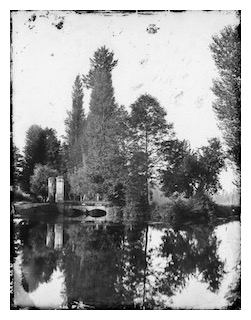
Brebissonia – Named in honor of Louis Alphonse de Brébisson (1798-1888). Brebissonia microphylla (Spach 1835) is now synonymous with F. microphylla (Humboldt, Bonpland & Kunth 1823). See F. microphylla and F x bacillaris, in ➤ Section Encliandra; Brébisson.
Breedlove, Dennis E. (b. 1939) – American botanist. Breedlove has collected and published extensively on the plants of Central America and Mexico, especially of Chiapas, including Fuchsia. His 1968 doctoral thesis at Stanford University, in fact, was published in 1969 as The Systemics of Fuchsia sect. Encliandra (Onagraceae). As a former curator in the Botany Department at the California Academy of Sciences, Breedlove was instrumental in establishing the Central American Cloud Forest Garden in the San Francisco Botanical Garden at the Strybing Arboretum in Golden Gate Park.
He is also noted for having made the only collection of seed from a rare and beautiful member of the Coffee Family found growing in only one valley near the Pacific Coast in the Mexican state of Chiapas. On Breedlove's next expedition, Deppea splendens (see also), the so-called "golden fuchsia", was found to have gone extinct in the wild due to the clearing of its restricted habitat for farming. Luckily, it is preserved in the Cloud Forest Garden at the SFBG and in other botanical gardens [including one potted specimen at Fuchsia in the City's own Hortulus Fuchsiarum].
Brevilobis – Exhibiting short lobes. See F. brevilobis (Berry 1989) in ➤ Section Quelusia. No synonyms of this species are recorded.
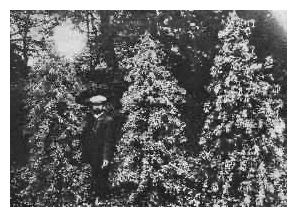
Bright was the son-in-law of another noted Victorian hybridizer, ➤ James Lye (d.1906), and was to become a grower of magnificent ➤ fuchsia pyramids in his own right as well. Lye's daughter, Emily (b. 1854), married Bright in 1879 and one of James Lye's many introductions was called 'Mr. F. Bright' (1886) in his honor. Two of Bright's children are recorded as having been born at Earley near Reading.
Bright himself was born at Weston, near Bath, in 1853, but apparently spent most of his working life from 1883-1920 gardening for the Carslakes and the Friedlanders at Whiteknights Park in Reading. He does also rate several mentions in the Gardener's Chronicle, starting in 1888, when he took second place at an exhibition by the Reading Horticultural Society with the staging of an unnamed fuchsia in the category of "Stove and Greenhouse Plants". Then he is described as the "gr. to R. Kerslake, Esq., White Knights". Lastly, Bright's passing is noted in an obituary published in the 1934 edition of the Chronicle at his death in nearby Shinfield, where he seems to have lived in retirement.
(Illustration: Fredrick Bright standing among his large fuchsia pyramids in an undated photograph.)
Brinco-de-princesa – A common name for the fuchsia in Portuguese. Literally "Princess's Eardrops."

Brittonii – F. brittonii (I.M.Johnst. 1925) is a synonym of F. sanctae-rosae (Kuntze 1898) in ➤ Section Fuchsia.
Bud – Undeveloped or embryonic shoot usually found in leaf axils or at the tips of stems. Fuchsias are pinched or stopped to activate dormant buds into growth and develop a bushier and more floriferous plant. See also Flower Bud.
Bullate – Leaves, especially, that have a puckered or blistered surface. Similar to ➤ rugose, but not quite the same.
Bulletin – The name of the periodical publications both of the American Fuchsia Society (quarterly) and the British Fuchsia Society (biennially).





